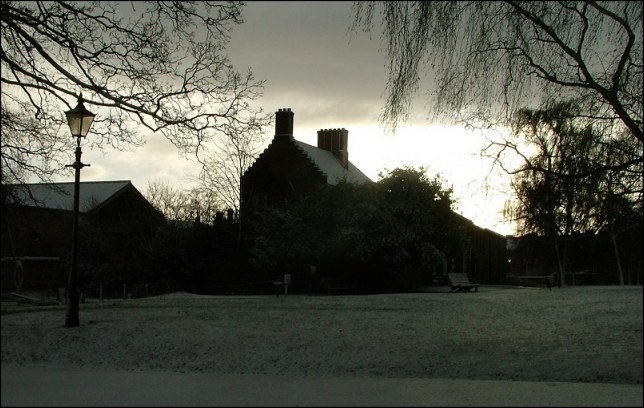| |
|
St Mary
in the Marsh, Norwich Reading the rest of this site, you
might think that all the Norwich churches which have been
lost were out in the industrial districts of Conesford
and Pockthorpe. But another which has survived only as a
name was St Mary in the Marsh, which was right in the
heart of the medieval city. In fact, it was in the
cathedral close, a city within a city, walled off from
the rest and entered by guarded gates. It was the parish
church for the cathedral close, and was situated in the
lower close, towards the river.
It was
originally founded by Herbert Losinga, first Bishop of
Norwich. He actually founded it before he became Bishop
here, as an act of penance for commiting the sin of
Simony. The Pope seems to have realised that Losinga was
worth a bob or two, because as part of the same act of
Penance he was also asked to build the great churches of
St Margaret at Lynn and St Nicholas at Yarmouth, the two
biggest in Norfolk. In return, the Pope let him move the
See from Thetford to Norwich, which must have been so
much more convenient for the football and the shops.
In common
with the other Norwich city churches, St Mary in the
Marsh was extended and rebuilt as the centuries went by.
There was money being spent on it in the late 15th
century, because it acquired then what we now consider to
be one of the great treasures of the English medieval
Church, a Seven Sacrament Font. There are about thirty of
these fonts surviving today, and they depict on seven of
the eight sides of their bowl the seven sacraments of the
Catholic church.
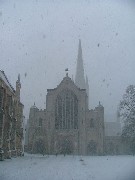 |
|
It
may seem curious to us that St Mary in the Marsh
continued to thrive after Losinga built the
Cathedral beside it, but the functions of a
Cathedral and a parish church are quite
different, and were even more so in those lost
days of Catholic England. While the Cathedral was
the place where the Bishop exerted his authority,
the parish churches were in the business of
dispensing the sacraments to those who lived in
their parish. Once the Reformation came along
there were fewer sacraments to dispense, but
still the church marked the stages in the life of
its parishioners, baptising, marrying and burying
them, as well as drumming the bible into them of
a Sunday. The function of a church changed at the
Reformation from being largely devotional to
almost wholly congregational. Devotional worship
can use as many churches as it can get its hands
on, because the aisles can be filled with chapels
and side altars, statues and images, where people
can say their prayers in private. Congregational
worship doesn't need any more churches than it
has people to fill them, and Norwich had no
shortage of churches. |
Several of
the city churches were obviously surplus to requirements,
and St Mary in the Marsh was one of the first to go. In
1564, just six years into the reign of Elizabeth, it was
pulled down, and the materials sold off.
There was
still the messy business of what to do with the
parishioners. Redrawing parish boundaries wasn't as easy
as you'd think; parishes formed areas of legal
jurisdiction, and changing the boundaries had financial
implications for the parishes around it. The Bishop
decided on a quick fix solution - the parish of St Mary
in the Marsh could use, as its parish church, one of the
chapels inside the Cathedral. And so, people continued to
be baptised and married in the parish of St Mary in the
Marsh.
This would
be no more than an interesting historical footnote, if it
was not for one intriguing detail - when the Bishop gave
the chapel to the parish, he let them bring their font
with them. And so it survives today, still in the chapel
of St Luke on the south side of the ambulatory, the 15th
century font from the church of St Mary in the Marsh.
As you can
see below, it was a good one, but has been severely
battered. This was probably to make it flush enough to be
plastered over, although the scene of the crucifixion,
which forms the odd-panel-out on the eighth side, seens
to have been singled out for particular vandalism. The
panels show, anti-clockwise from the east, Confirmation,
Mass, Confession, Matrimony, Baptism, Ordination,
Crucifixion and Last RItes.
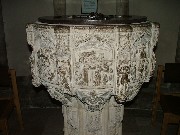 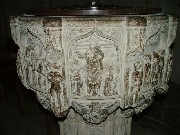 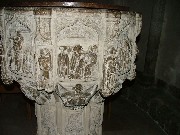 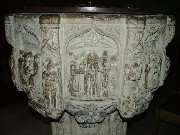
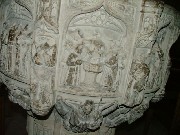 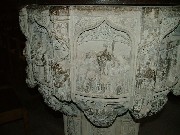 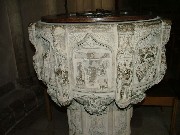 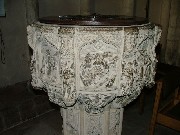
St Luke's
chapel is just one of several chapels radiating from the
apse of the cathedral. It is very small, with room for
about 30 modern chairs. The parish still exists, its
incumbency tacked onto one of the Cathedral canonries at
no extra cost, and the chapel is still used today;
baptisms still occasionally happen at this amazing font.
The font
was joined in the chapel in 1847 by another extraordinary
medieval survival. This is the Despenser retable, an
altar back of the 1380s, probably given as a thanks
offering for the survival of the King during the peasants
revolt. During the Reformation it had been thrown out,
and was presumed destroyed; but in the early 19th century
it was discovered upside down, serving as a table. Here
in this tiny chapel, then, two touchstones to the past.
Simon Knott, December 2005
|
|
|

